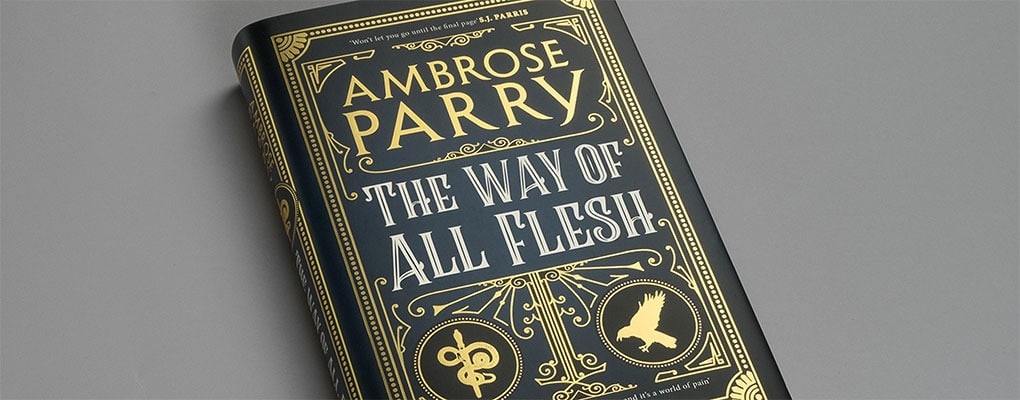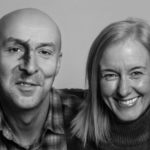Books
Ambose Parry: on collaboration
Looking back, it sounds like an ingeniously alchemical combination: the experienced crime writer and the consultant anaesthetist (also boasting a Masters degree in the History of Medicine) combining their expertise to pen a historical thriller about the pioneering days of anaesthesia. But to get a sense of what it sometimes felt like, flip it around and consider how it sounds to suggest the same duo divide the duties on an operating list, requiring the writer to have a crack at gassing patients while his wife assures him that she’s just through the wall in the next theatre if anything goes wrong.
Like many great and many terrible ideas, it started over dinner and a bottle of wine. Marisa was working on her Masters dissertation, researching James Young Simpson and the early days of obstetric anaesthesia. Chris had just finished writing a novel and was, as always at that point, ready to be intoxicated by the next great story idea. In truth, it was the sheer volume of stories Marisa uncovered that intoxicated both of us: the way Simpson’s life and work had transcended the social strata of Victorian Edinburgh.
We can no longer remember who first said: “This would make a great novel”. It’s the kind of thing you say towards the end of that bottle of wine and then forget about it the next day, or at least hope the other person has. But it was an image that wouldn’t fade. Chris had always wanted to write a historical novel but didn’t feel he could spend the necessary time to research it, given his prolificity in delivering a book a year. Having completed her Masters, Marisa was considering whether she might like to further pursue her interest in Simpson via a PhD. We used to joke that if we wrote a novel about Simpson instead, it would cost considerably less in tuition fees and the finished product might be read by more than three people. At some point, this moved from being a joke to seeming a realistic, achievable undertaking, and the more we talked about it, the more fortunate we felt that nobody had beaten us to the punch.
After her degree, Marisa went back to work doing locum shifts in the hospital where she had been a consultant, planning to divide her time between anaesthetics and the book. However, her professional duties quickly began to dominate, and Chris had always been of the opinion that you have to be totally committed to a novel: thinking about it and working on it exclusively over a prolonged period. At this point, Marisa took possibly the bravest and possibly the most foolhardy decision of her life, choosing to concentrate full-time on the book.
Over the course of two years, Marisa garnered and processed a wealth of background research, which was to provide the foundation upon which the novel was built. Having done that however, we were left with the question of how to turn it into a story, and indeed of whose story to tell. We decided early on that it couldn’t be merely a fictionalised account of Simpson’s life. For one thing, it would run to 1,000 pages, but more pertinently, people don’t easily identify with brilliant, exceptional individuals. We thought it would make better drama to refract that brilliance through the lives of the people who find themselves closest to it. Our handy point of comparison was The West Wing, which is not about President Bartlett, but the people working for him.
We sat down to many meetings at our kitchen table, Chris with his laptop and Marisa with her preferred planning aid: a pad of A4 lined paper and a freshly sharpened pencil. Together we began to decide how we could best tell the story, and what kind of story it ought to be.
Like many great and many terrible ideas, it started over dinner and a bottle of wine.
We decided that the book should focus on Simpson’s household, as it was one of the things that inspired us in the first place. It was a truly bizarre and unique institution, a chaotic family dwelling within which Simpson treated patients — from the poor off the streets to far-travelled aristocrats — and where luminaries from the fields of art, literature, medicine, science and politics would regularly pass through. Marisa came up with the idea of making our protagonist Simpson’s apprentice, having learned that such proteges not only trained under him but were invited to live at the Simpson home. This, in turn, led to her adding the character of Sarah Fisher, a housemaid frustrated by the limitations of her station, as Marisa wanted to bring a female perspective to bear upon the stark gender inequalities of a male-dominated world.
Having written Want You Gone and then Places in the Darkness back-to-back within eighteen months, Chris was free of outstanding commitments and able to concentrate fully on the collaboration. In the meantime, Marisa had produced a 70,000-word document that was part outline, part narrative non-fiction, part dramatization of real historical events and part sketchpad. It was like a very early study for a painting, in that it bore scant resemblance to the finished work and yet the finished work could not have been envisaged without it.
Marisa had also done a lot of advance work on developing the language and tone. We wanted something that would invoke Victoriana but would not bog down the reader in trying to parse the cumbersome sentence structure associated with the period. Marisa’s research had revealed that Victorians didn’t speak like that anyway: we just have this notion that they did because we have no recordings upon which to base our impressions, only books and letters. People are far more articulate and complex in their phraseology when they are writing something than when they are extemporising vocally.
Perhaps surprisingly, our first vision was not of a crime novel. Chris felt he wanted to concentrate on what he considered the book’s USP: the medical and social history of Simpson’s world. We began to work on what we described as the battle for the soul of our young apprentice Will Raven, tempted by the pursuit of wealth and self-aggrandisement as was often the case in medicine at the time. The story would be his journey to the light, won over by his exposure to Simpson’s humanitarianism.
It was as we began to develop the character of the antagonist that Marisa, rather than Chris, decided it should be a crime novel, as the genre reflected what had attracted us to Simpson in the first place: something that interrogated all levels of how a society functions.
It was after this decision that we really turned on the after-burners. We constructed a story structure comprising a list we called “Scenes We’d Like To See”, after Mock The Week, and at that point we were truly able to divide the labours. Chris took charge of the Raven scenes, often working from Marisa’s earlier drafts, which meant that with the medical detail already in place, he could concentrate on plot. As a novice writer, Marisa was more comfortable writing chapters that had been mapped out in advance within a structure that was visibly taking shape. She took on the chapters from Sarah’s point of view, and this separation reflected the parallel nature of the characters’ lives: on different tracks despite living under the same roof.
It was like a buddy cop movie, where we both had to learn to be a bit more like each other in order to succeed.
Once we had each finished our chapters, we would swap over and revise the other’s work, Chris refining plot (and darkening the tone), Marisa picking up on medical or historical implausibility, as well as comparing notes on how we thought our characters would behave in any given circumstance. It was this swapping back and forth that really allowed us to create a consistency in the writing, so that it is hard to see the join where one left off and the other picked up.
Progress felt rapid at that time, but as with writing any novel, you can’t always see the way forward. This was when Chris would outline where he thought the story should go, and Marisa would respond with what we referred to as The Face. The Face was a look of confusion, scepticism and exasperation that never failed to leave Chris doubting not only the viability of the project in hand, but how he had ever managed to write the previous twenty-odd books, given he was clearly a woolly-minded hack whose thinking made no sense.
People always ask if there were disagreements, and The Face was the most vivid indicator of how our differing backgrounds did sometimes clash. Marisa had once studied watercolour painting, and been told by her tutor that she had to lose sight of the image in order to find it again. Schooled by the necessary hyper-caution of her career in medicine, Marisa does not like losing sight of the image. By contrast, becoming lost in your own story in order to discover something surprising is what Chris considers the most exciting part of the process.
It was like a buddy cop movie, where we both had to learn to be a bit more like each other in order to succeed. Tempting as it was to step away and say: “let’s come back fresh tomorrow,” we never got up from the table until The Face was gone and Marisa’s notepad filled with a few more pages of scribbles, arrows and double underlines. Chris learned that The Face meant whatever he was trying to outline was not clear enough in his own mind, and we would work to refine the ideas and fill in the blanks on the map. Marisa for her part learned that sometimes, in order to fill in those blanks, you have to wander into uncharted territory and see where it takes you.
When we look at the finished product, we like to think it’s not clear where Marisa ends and Chris begins. Perhaps ironically, the one scene in the book which readers are reliably horrified by was not the work of a seasoned crime writer with a reputation for stomach-churning gore. For the most part however, we can’t remember who wrote which line or what was whose idea, though Marisa has a helpful rule of thumb regarding this matter. If somebody has a problem with anything, she says Chris wrote it, and if they highlight a passage they particularly admire, then that was all her.
Chris is of the opinion that she’s probably right about this, but then Marisa had the final pass on this article.
Have you picked up The Way of All Flesh by Ambrose Parry yet? Let us know in the comments below!



Please note: Moderation is enabled and may delay your comment being posted. There is no need to resubmit your comment. By posting a comment you are agreeing to the website Terms of Use.